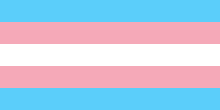Khanith
| Part of a series on |
| Transgender topics |
|---|
 |
| Identities |
| Topics |
| Attitudes |
| Legal issues |
| Lists |
|
|
Khanith or Khaneeth (Arabic: خنيث; khanīth) is a vernacular Arabic term used in Oman and the Arabian Peninsula and denotes the gender role ascribed to males who function sexually, and in some ways socially, as women. The word is closely related to the Arabic word mukhannath (مخنث "effeminate"), a Classical Arabic term referring to individuals with an effeminate nature.[1]
John Money summarizes material presented by Unni Wikan in an article titled Man becomes woman: Transsexualism in Oman as a key to gender roles. According to this account, the mukhannath is the "bottom" in a male same-sex relationship.[2] Because of this, khanith are considered men by Omani standards and are often considered an "alternative gender role"[3] – and sometimes considered as being transgender or transvestites[4] – even though the khanith are still referred to by masculine names and are treated as male by the law.[3] Because of this confusion in terminology, many people refer to the khanith as khanith alone.[4]
The khanith are considered a specific third gender category in Oman. And although they behave like women and have same-sex relationships with other men, at some stage they may one day "become a man" and give up their lifestyle for marriage and children.[5][6]
See also
References
- ↑ George Haggerty, ed. (2000). Encyclopedia of Gay Histories and Cultures. Garland Publishing Inc. pp. 515–516. ISBN 0-8153-1880-4.
- ↑ Man (N.S.) 12:304-319, 1977.
- 1 2 Nanda, Serena (1990). Neither Man Nor Woman: The Hijras of India. Wadsworth Publishing. pp. 130–131.
- 1 2 Wikan, Unni (16 January 2015). Resonance: Beyond the Words. University of Chicago Press. p. 173. ISBN 9780226924489.
- ↑ Professor Pinar Ilkkaracan, ed. (2008). Deconstructing Sexuality in the Middle East: Challenges and Discourses. Ashgate Publishing Ltd. p. 32. ISBN 978-0-7546-7235-7.
- ↑ Stephen O. Murray (2002). Homosexualities. University of Chicago Press. p. 278. ISBN 0-226-55194-6.
Bibliography
- Money, John (1988). Lovemaps: Sexual/Erotic Health and Pathology, Paraphilia and Gender Transposition in Childhood, Adolescence and Maturity (reprint ed.). Irvington. ISBN 0-87975-456-7. Retrieved 5 March 2015.
- Roscoe, Will; Murray, Stephan (1997). Islamic Homosexualities: Culture, History, and Literature (illustrated ed.). New York University Press. ISBN 9780814774687. Retrieved 5 March 2015.